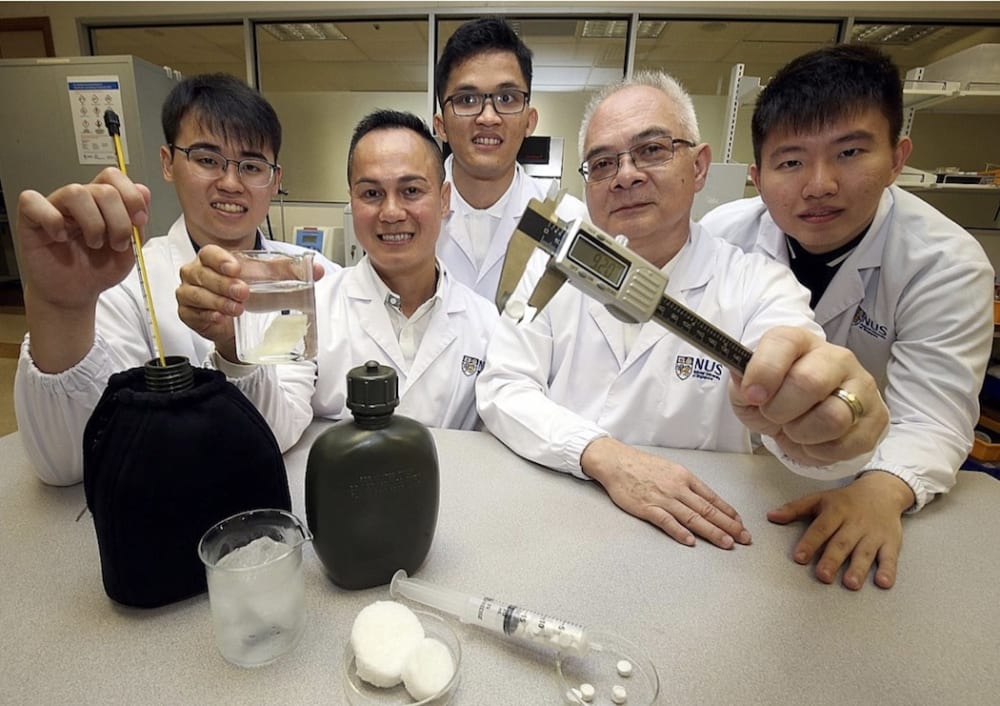


Recycling environmental waste can avoid many hazardous environmental scenarios and save our resources. Our aerogel technology can recycle various environmental wastes to high-value engineering materials. Common paper, fabric and plastic wastes are selected to develop the lightest aerogel materials for novel applications such as oil-spill cleaning, heat and sound insulation, winter garment materials, packaging, CO2 filtering, personal care and medical products.
Using an cost-effective and green sol gel technique with no toxic solvents and cross-linkers, recycled fibres from the wastes are converted into ultralight porous, biodegradable and non-toxic aerogels. Our method uses 70% less energy and results in reduced polluting emissions into the air and water. It is also faster as the entire process takes only 8 hrs to 1 day. This is 20 times faster than current commercial processes. Thus we can significantly reduce manufacturing and equipment costs. The manufacturing cost of an A4-size aerogel sheet is approx. US$0.5-2.0, much cheaper than commercial Aspen aerogels for heat insulation or commercial sorbents for oil spill cleaning. The developed aerogels are highly compressible for the first time; hence storage and transportation costs are greatly reduced. The compressed aerogels can very quickly recover 97 % of their original size when placed in water. The used aerogels can be recycled so no waste is disposed to the environment.
The above highly compressible, cost-effective and biocompatible hybrid aerogel pellets can be easy integrated into a clinical syringe to be used as a haemorrhage control device. Each compressed aerogel pallet can expand in volume to 16 times its size in 4.5 seconds, 3 times faster than commercial haemorrhage devices, while retaining their structural integrity. The fast aerogel expansion also exerts high pressure to stop the wound bleeding within 5 seconds.
The aerogel surface can be functionalized effectively by the nanocoating method at low temperature for the above-mentioned applications. For example, the MTMS-coated aerogel can absorb oil 99 times of their dry weight and 4 times as effective as commercial oil sorbents. They can be reused several times and can be recovered by squeezing out over 99 % of oil absorbed. At the end of their useful life, the used aerogel can be safely ground into fine particles and discarded. This potential market has been estimated at US$143.5 billion. With amine group coating, the amine-coated aerogels can absorb large amounts of CO2 from air. Also with fire retardant coating, the aerogels can withstand an ambient temperature of 600-620 oC and prevent fire from spreading inside buildings. The potential market of thermal insulation is US$3.3 billion globally. Beside the heat and sound insulation of the buildings, we also developed successfully a lightweight thermal jacket using aerogels, to insulate water bottles, to maintain the temperature of ice slurry at -1oC for 4 hours. A thermal jacket consists of an aerogel layer embedded within common fabrics to provide effective heat insulation. The aerogel-insulated bottle offers better heat insulation performance than commercial FLOE bottles and is highly comparable to that of vacuum flasks, but at a fraction of the cost.
Video
-
Awards
-
 2018 Sustainable Technologies Category Winner
2018 Sustainable Technologies Category Winner -
 2018 Top 100 Entries
2018 Top 100 Entries -
 2018 Top 10 Most Popular
2018 Top 10 Most Popular
Like this entry?
-
About the Entrant
- Name:Hai Minh Duong
- Type of entry:teamTeam members:Associate Professor Hai Minh Duong and Professor Nhan Phan-Thien, National University of Singapore ( NUS), Singapore
- Patent status:patented








